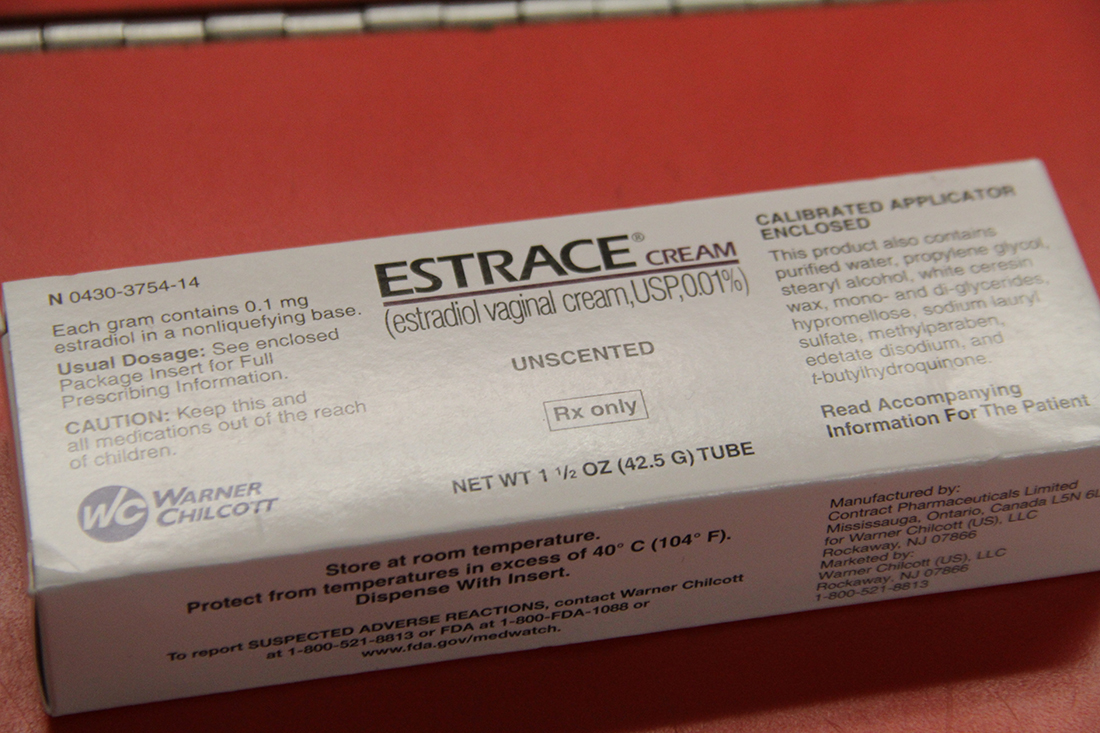SILVER SPRING, Md. — “This is severe pain. This is defeating. This is life-changing and has no end in sight…Pain is excruciating. [It] felt like someone was stabbing me with a knife. I could not breathe.”
Those are the words of women suffering the effects of untreated vaginal atrophy, a painful condition that’s effectively treated with low-dose of vaginal estrogen. The comments come from an abstract of a focus group that was originally presented at the North American Menopause Society’s October 2015 session in Las Vegas.
Dr. Sharon Parish, professor of clinical medicine at Weill Cornell Medical College in New York City, detailed the focus group findings at a recent FDA Scientific Workshop on Low-dose Vaginal Estrogen Products, held in Silver Spring, Md., in early November.
Parish’s report along with the pleas of other physicians were meant to convince the Food and Drug Administration to remove worrisome box warning labels on prescribed low-dose vaginal estrogen products. The warnings, they say, have frightened and deterred many female patients from using the recommended prescription.
The warnings list possible side effects, such as breast cancer, blood clots, dementia and more. But the warnings apply to doses that are much higher than the ones these women need.
Vaginal atrophy is a treatable condition. And the Cleveland-based North American Menopause Society states that low-dose vaginal estrogen is the preferred method of treatment when vaginal symptoms are the only issue.
This vaginal form of estrogen promises to provide sufficient local estrogen to relieve symptoms, decrease vaginal pH balance, and increase maturation or life cycle of the vagina with minimal systemic absorption. When low-dose estrogen is delivered vaginally, the hormone stays in the vagina with low risk of entering the blood stream.
However, the warning labels on low-dose estrogen products are preventing some women experiencing vaginal atrophy from addressing their pain. And some doctors are saying the listing of harmful side effects is unnecessary.
Lisa Larkin, director of the University of Cincinnati Women’s Center who spoke at the FDA workshop, said the boxed warnings are unfounded.
“This data from the Women’s Health Initiative (WHI) does not translate to low-dose vaginal estrogen,” Larkin said. According to her findings, there are no randomized trials or observational data to show that “low-dose vaginal estrogen carries the same risk as the higher forms of systemic hormone therapy.”
In 2002, the Journal of the American Medical Association said the boxed warnings stemmed from data collected by the WHI on clinical trials of higher “systemic doses” of estrogen – not the low-dose vaginal estrogen
Thirteen years later, physicians are still imploring the FDA to modify the verbiage on these labels because the current language deters women from using the highly effective low-dose vaginal estrogen products. The fear is creating barriers and anxiety for many women in need of treatment, critics say.

The FDA held a Scientific Workshop to discuss low-dose estrogen-alone products for symptoms of Vulvar and Vaginal Atropy (Angela G. Barnes/Medill)
Larkin said there are more than 60 million postmenopausal women in the U.S. Half will develop Vulvovaginal Atrophy (VVA). However, only 10 percent will be treated properly, leaving 27 million women untreated.
At its November workshop, some medical professionals argued that the FDA didn’t deal directly with concerns about the box labels on estrogen products delivered vaginally. Instead, government officials focused on explanations of the uses of oral and transdermal lotions and patches that deliver systemic doses of hormones as an alternative to vaginally delivered estrogen products.
Dr. James A. Simon, obstetrician-gynecologist at Healthcare for Women in Washington, said the FDA workshop was confusing.
“The FDA stated there was not enough time to pull the necessary data together to engage in dialogue about low-dose vaginal delivery products,” Simon said in a telephone interview. “This does not make sense…I believe it was a cop out.”
Another doctor, Steven R. Goldstein, professor of Obstetrics and Gynecology at New York University’s Langone Medical Center, also expressed frustration.
“I think it’s unfair…they said they didn’t have time to tease out the data for vaginal versus other low-dose estrogens. If there wasn’t time, don’t hold the workshop,” Goldstein said. “This is unfair…I feel like writing my congressman.”
In a notice posted at FDA.gov, the FDA described the workshop as offering “an opportunity for [the] FDA to obtain input from experts on several topics related to the product label of lower dose estrogen-alone products approved solely for the treatment of moderate to severe symptoms of VVA due to menopause.” In addition to discussing the relevance of the boxed warnings.
Parish, who is also president of the International Society for the Study of Women’s Sexual Health, said the FDA workshop was a start in addressing the problem related to the boxed warning labels. Yet, it’s still not clear when or if the box warnings will be modified for low-dose vaginal estrogen products.
What is Vaginal Atrophy?
According to the North American Menopause Society, VVA is a common progressive condition that affects the quality of life for many postmenopausal women with an average age of just older than 51. The society says the condition affects 20 percent to 40 percent of midlife and older women.
More than 32 million women suffer from this condition, according to Dr. Simon.
“Vaginal atrophy is a natural event that happens after menopause to all women,” Simon said. “It mainly affects partnered woman who engage in sexual contact.”
The Real Women’s Views of Treatment Options for Menopausal Vaginal Changes survey conducted in 2012 indicated that an estimated 45 percent of older, postmenopausal women suffer painful VVA symptoms. These include vaginal dryness, recurring urinary tract infections, severe pain or bleeding during sexual intercourse, vaginal infections and inflammation along with other non-sexual ailments.
Research at the North American Menopause Society showed untreated VVA can result in tearing of vaginal tissue during sex without proper lubrication.
Renee Miller, a 55-year-old resident of Mount Vernon, Iowa, said she went through a period of vaginal discomfort.
“I experienced more painful intercourse,” said Miller, a state correctional employee. “I didn’t want to have sex because it wasn’t comfortable.”
If not treated, a condition such as Miller’s can have damaging effects on sexual relationships and a woman’s quality of life, according to the U.S. National Library of Medicine.
The Real Women’s Views of Treatment Options for Menopausal Vaginal Changes online survey identified 3,046 women with VVA symptoms, showing:
- 85 percent of women with partners reported “some loss of intimacy”
- 59 percent of women reported vaginal atrophy symptoms detracted from enjoyment of sex
- 47 percent of partnered women indicated VVA interfered with their relationships
- 27 percent reported VVA had a negative effect on their quality of life
Low-dose Vaginal Estrogen Product
The North American Menopause Society study showed that low-dose vaginal products and systemic oral therapy have both proven effective in relieving symptoms of vaginal atrophy. Yet the study showed that 80 percent to 90 percent of women experienced favorable results after using vaginal estrogen, compared to 75 percent of women using oral estrogen. In other words, the vaginally delivered estrogen seemed to work better.
Renee Miller, who has been using low-dose vaginal estrogen for three years, said the hormone restored her sex life.
“Yes, it is helpful,” she said. “It definitely increases the quality of your sexual interaction because you just feel better…things feel more comfortable.”
As for the label warnings, Miller said she hadn’t paid much attention to them.
Prescription Warning Labels
Critics say the FDA is leaving women with uncomfortable choices because of the unnecessary warnings on the low-dose estrogen prescriptions.
“The current boxed warning on low-dose vaginal estrogen products for the treatment of VVA is unfair to women,” said Goldstein. “It doesn’t give the right message to women to protect and increase their safety.”
The warning label in question reads:
“WARNING: ENDOMETRIAL CANCER, CARDIOVASCULAR DISORDERS, BREAST CANCER and PROBABLE DEMENTIA.” (North American Menopause Society)
Lisa Larkin says the troubling package label on low-dose, vaginally delivered estrogen prompts some patients “to use compound hormone therapy [as an alternative] believing that it’s safer.”
But some of these compounded products are unregulated, she said, and are not FDA-approved.
The Road Ahead
Although the FDA made the box labels inclusive for many of its hormone products: pills, transdermal lotions or patches and vaginal, Doctor Simon said the agency’s decision was understandable.
“I think the FDA…had the right intentions,” said Simon. “They didn’t know about all the products, so they made the assumption without specific information on other products.”
Simon said the FDA used information it had at the time in an effort to protect the public. Medical science now has more information and a better understanding of the risks and benefits of estrogen products; therefore, the labels should be modified accordingly, he said.
A new FDA regime is scheduled to take over in late February, assuming Dr. Robert Califf is confirmed by the U.S. Senate as FDA commissioner. Califf is currently the deputy commissioner of medical products and tobacco.
In the meantime, physicians like Simon plan to continue to educate and quell anxieties of patients who suffer from VVA because they shun low-dose vaginal estrogen out of concerns raised by the box label warnings.
“We try and explain it to them that there’s no reason for their fears…the box warning is wrong…the FDA needs to change it,” Simon said.


